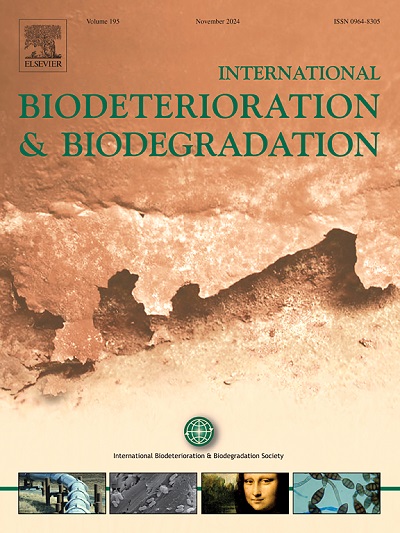Monoterpenes profile and high temperature as a potential factors in the infestation of wooden structures by Hylotrupes bajulus L
IF 4.1
2区 环境科学与生态学
Q2 BIOTECHNOLOGY & APPLIED MICROBIOLOGY
International Biodeterioration & Biodegradation
Pub Date : 2024-09-26
DOI:10.1016/j.ibiod.2024.105928
引用次数: 0
Abstract
Hylotrupes bajulus L. is a dangerous destroyer of wooden structures. Monoterpenes (mainly α-pinene and 3-carene) attract of this beetle females to lay eggs on wood. The phenomenon of sporadic occurrence of old house borer larvae in old wooden structures and its reappearance in these structures after the previous use of hot air to old house borer combating has been known for many decades. The causes of these phenomena were not explained. In this work, it was hypothesized that the cause of these phenomena was poor attraction of this wood for females due to the reduced amount of monoterpenes in such wood. An experiment was carried out on the possibility of developing old house borer larvae in old natural aged wood. Tests were also carried out on the profile of monoterpenes in uninfested old natural aged wood, contemporary wood and contemporary wood after heating at high temperature. The possibility of development of newly hatched H. bajulus larvae in old natural aged wood and a high concentration of monoterpenes (mainly α-pinene and 3-carene) in such wood were found. The sporadic presence of old house borer larvae in very old wooden structures cannot be explained directly by a reduction in the concentration of attracting monoterpenes. The concentration of monoterpenes in contemporary wood after exposure to high temperature was whereas significantly reduced. This may be the reason for sporadic cases of repeated attacks on structures previously exposed to very hot air.
单萜烯类化合物和高温是 Hylotrupes bajulus L 侵害木质结构的潜在因素
Hylotrupes bajulus L. 是木质结构的危险破坏者。单萜烯(主要是 α-蒎烯和 3-蒈烯)会吸引这种甲虫的雌虫在木材上产卵。旧木结构中零星出现老房蛀虫幼虫,以及以前使用热空气防治老房蛀虫后这些结构中再次出现老房蛀虫幼虫的现象已为人所知几十年。但造成这些现象的原因却没有得到解释。在这项工作中,我们假设造成这些现象的原因是这种木材对雌虫的吸引力差,因为这种木材中的单萜含量减少。我们进行了一项实验,研究老房子螟幼虫在天然老化木材中生长的可能性。此外,还对未受侵染的天然老龄木材、现代木材和高温加热后的现代木材中的单萜烯含量进行了测试。结果发现,新孵化的巴氏蝙蝠幼虫有可能在天然老龄木材中生长,而且这些木材中的单萜烯(主要是 α-蒎烯和 3-蒈烯)浓度较高。在年代久远的木质结构中零星出现老屋蛀虫幼虫,并不能直接解释为吸引幼虫的单萜烯浓度降低了。暴露于高温后,当代木材中单萜烯的浓度明显降低。这可能是以前暴露在高温空气中的木结构反复受到攻击的零星案例的原因。
本文章由计算机程序翻译,如有差异,请以英文原文为准。
求助全文
约1分钟内获得全文
求助全文
来源期刊
CiteScore
9.60
自引率
10.40%
发文量
107
审稿时长
21 days
期刊介绍:
International Biodeterioration and Biodegradation publishes original research papers and reviews on the biological causes of deterioration or degradation.

 求助内容:
求助内容: 应助结果提醒方式:
应助结果提醒方式:


